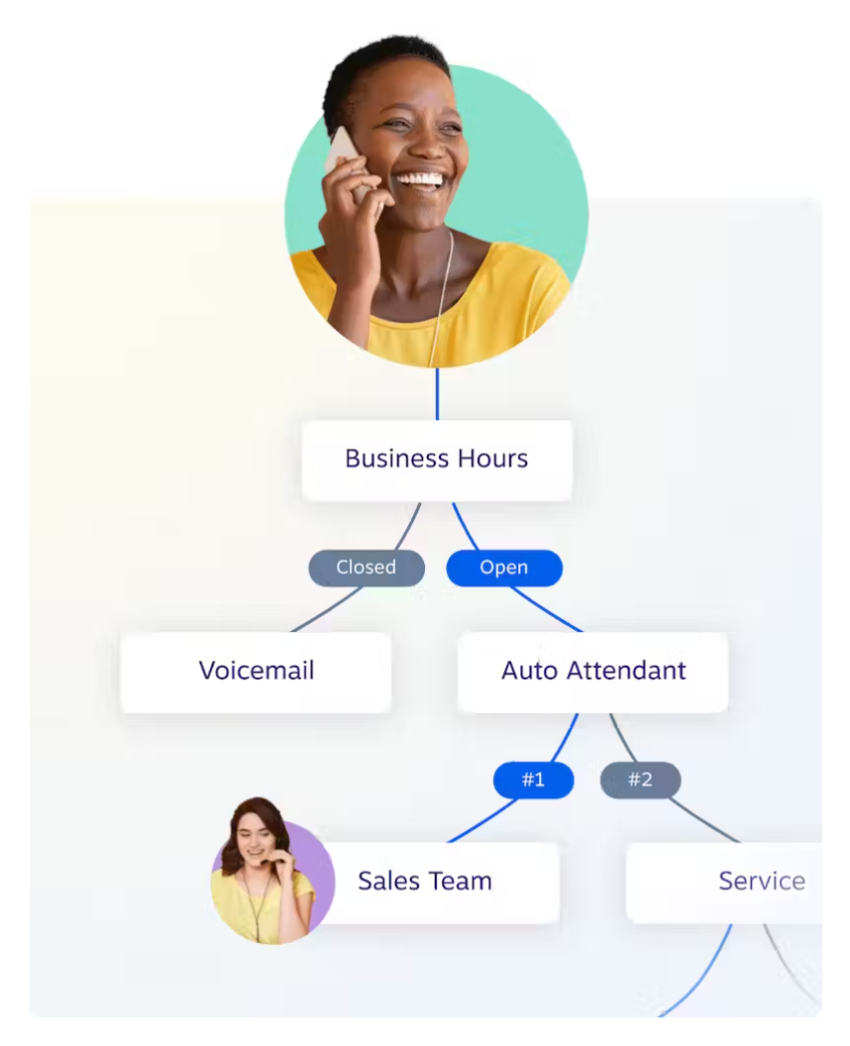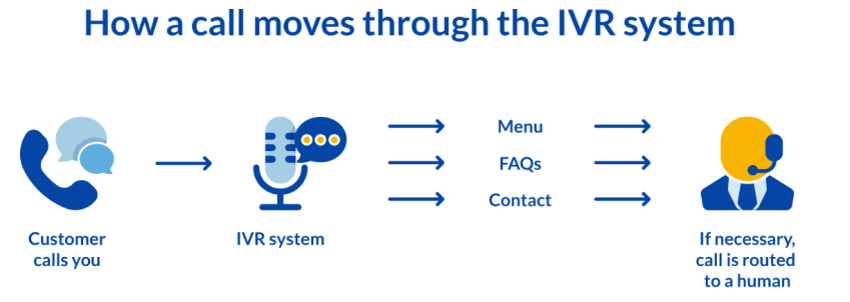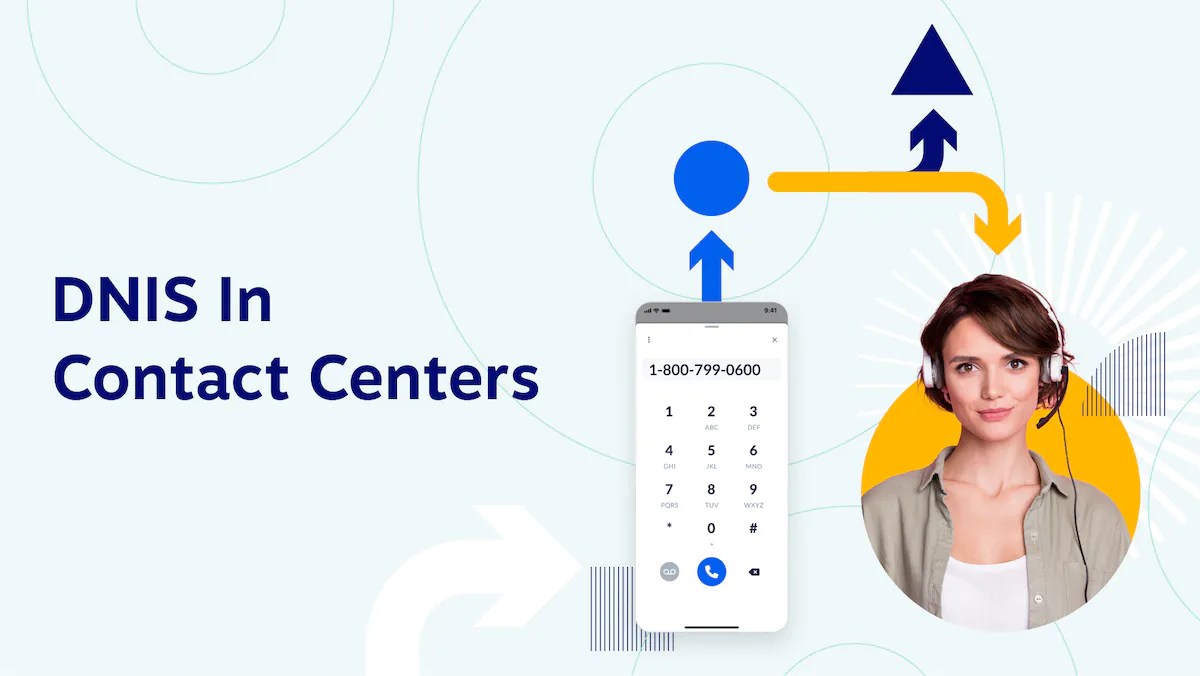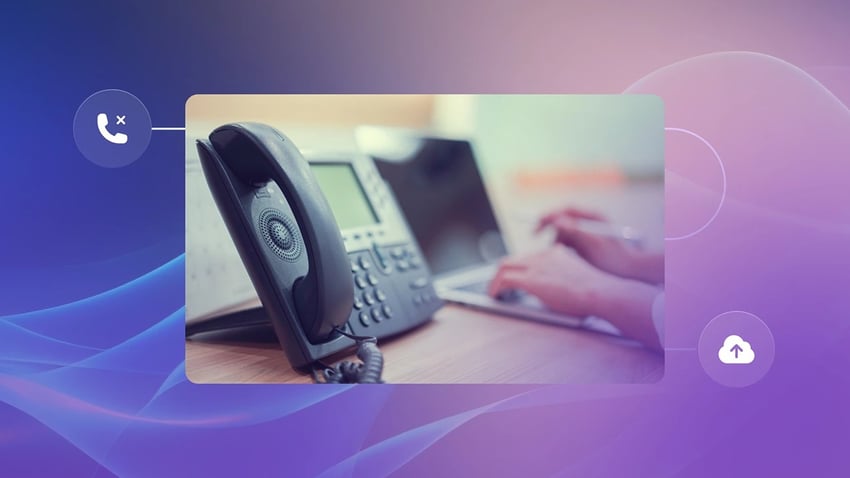If your contact center is struggling with long wait times and inefficient call handling, it might be time to integrate DNIS technology into your call flow setup.
This article explains what DNIS is and how it can transform your contact center and improve overall customer communications.
What Is DNIS?
DNIS stands for Dialed Number Identification Service. It is a telecom technology used in call and contact centers to identify the number dialed by a customer, especially for toll-free calls. The dialed phone number is presented to the agent and the company’s phone system.
In simple terms, when you call 1-800-555-1212, the agent will be able to see the number you dialed and your automatic number identification, regardless of the agent’s phone extension or call routing that took place before.
DNIS helps in routing calls to appropriate agents or departments based on the number the customer dialed. This ensures that the customer is connected to the right agent for their needs, delivering a more satisfying customer experience.
How Does DNIS Work?
Let’s walk through the four primary steps of how DNIS works.
1. Automated distribution through call routing
DNIS is part of the call routing system that determines where an inbound call is directed based on several factors, including the dialed number.

The DNIS data are encoded in the phone number as dual-tone multi-frequency (DTMF) digits or touch-tone digits. Once the customer dials the number and the call comes through, the DNIS data go into the automatic call distributor (ACD) to identify the dialed number.
Here, the call is mapped to specific services or actions within your cloud phone system. For example, a contact center can assign separate phone numbers to different interactive voice response (IVR) menus, departments, or agents. Also, high-value customers or urgent service lines might have unique routing options.
The ACD may perform database lookups to retrieve additional information about the dialed number or the caller — such as customer records, preferences, or other relevant data stored in a backend system.
Based on the DNIS information and any additional data retrieved from the databases, the system routes the incoming call to the right recipient.
2. IVR integration
DNIS is often integrated with IVR for efficient call handling. An IVR system communicates with customers using voice or touch-tone keypad inputs. It’s what you speak with several seconds into your toll-free call before you’re eventually transferred to a human agent.
The IVR checks the DNIS data to identify the dialed number. Based on the encoded information, it can play a customized greeting. For example, if a caller dials a Sales number, the IVR might start with a greeting like, “Thank you for calling Sales.”

It may present menu options to the caller based on this information. The caller might hear something like, “Press 1 for Invoices, Press 2 for Technical Support, Press 3 for General Inquiries.” The IVR can also use the DNIS data to guide the caller through the appropriate menu options and, based on the caller’s input, route the call to the right department or contact agent.
This DNIS–IVR integration saves customers time they would have spent talking to the wrong agent or transferring between agents until they found someone to solve their issue. It’s also better for your agents — they handle calls faster when connected with best-fit customers immediately.
3. Call routing
DNIS lets businesses route calls to different teams or departments. For example, you might have one phone number for sales, another for billing, and yet another for refunds. Each number has unique DNIS information, allowing your call center to automatically route calls to the appropriate department or agent, ensuring efficient traffic management.
Assigning distinct call paths for different departments, agents, and product lines is a common DNIS use case, but it doesn’t end there.
If your business is multinational, you might have separate phone numbers and codes for each region or language. Calls from each region can be routed to a local office or agents who speak the regional language. For example, if your business has customers in England and France, you can route phone calls that originate in France to an agent in England who speaks French.
This setup allows you to deliver multilingual customer support at scale without setting up a physical presence in each location.
4. Caller experience improvements
DNIS delivers a stellar contact center experience for agents and customers through:
- More personalized interactions: When a customer calls, DNIS identifies the dialed phone number and sends the caller to the corresponding IVR system. The IVR presents a customized menu or options to the customer based on this information. As the customer interacts with the IVR, the options become more personalized.
- Faster resolution times: DNIS connects customers to the best-fit agents quickly, eliminating unnecessary wait times. Agents can resolve issues faster when they are connected to customers whose problems match their expertise.
- Greater brand consistency: This service tailors the caller experience to the specific context of each dialed number across different campaigns and services. That way, callers enjoy consistent hyper-personalized customer experiences no matter when they interact with your brand.
- Improved customer insights: DNIS provides insight into customer preferences and behaviors, improving your inbound call center efficiency.
Benefits of DNIS in Contact Centers
Integrating DNIS into your contact center offers several impressive benefits. Here are some of the advantages of setting up DNIS with your contact center software.
1. Improves call management
According to The Replicant’s (2021) survey, long wait times due to poor call management are the number one cause of customer frustration with contact centers.
DNIS improves call management through automated skill-based call routing and strategic staffing.
- Skill-based routing: DNIS uses information from your agent skill database to route calls to the most qualified agent to help the customer.
A customer doesn’t need to go through multiple agents to find one who can resolve their issue. When calls are routed correctly, agents respond quickly and hold times go down.
- Strategic staffing: DNIS data helps managers identify peak times for certain types of calls and plan ahead to handle them efficiently.
For example, if you know that Sales receives the most calls on Fridays, you can assign more call center agents to the Sales phone lines to manage these calls and reduce hold times.
2. Enhances performance tracking
Call center managers can use DNIS to track the number of calls coming in for each department, the length of each call, the number of calls resolved on the first try (first call resolution), and call center metrics. This information is useful for optimizing staffing levels, adjusting call routing strategies, and providing specialized training to improve agents’ skills.
You can also integrate DNIS with other performance tracking tools, such as customer relationship management software, to better understand customer interactions and behaviors.
That’s not all. DNIS can help you track marketing efforts and campaign results. All you need to do is assign unique phone numbers to your marketing channels, such as print ads, billboards, TV or radio commercials, or online ads. These phone numbers should be specific to the campaign and not be used elsewhere.
When a potential customer calls the phone number, the call tracking software or system will use DNIS to record which marketing channel the call came from. You can then use these data to track campaign response rates and other qualitative data to measure your outreach’s success.
3. Delivers seamless customer experiences
More than 90% of respondents in HubSpot’s 2022 Customer Service report will likely buy multiple times from a business that repeatedly delivers excellent customer experiences:

Integrating DNIS into your contact center will improve customer satisfaction at scale. It replaces inefficient manual routing processes with automated call routing backed by data. Customers won’t deal with the frustration of long wait times and manual transfers.
DNIS helps business leaders better manage their customer experience. Automatically directing calls to the appropriate agents or teams based on the nature of the call minimizes call transfers and ensures that each inquiry is forwarded to the right agent for quick resolution.
On top of that, DNIS captures important data to help you understand customer behaviors and agent performance on inbound or outbound calls and discover hidden lapses in call center productivity.
Get DNIS & All the Contact Center Features You Need
Why stop at DNIS? You can get all the contact center features you need with a complete solution like Nextiva.
DNIS, IVR, and intelligent call routing bridge your online and offline channels and power your business communications through one platform. Everyone can run on a unified communications platform — even contact center agents.
There are many cloud contact center providers on the market, but Nextiva stands out. With a comprehensive feature set, top-notch reliability, and customer-obsessed service, Nextiva helps businesses of all sizes create exceptional customer experiences that can scale.
Scale up with contact center AI
The modern contact center has arrived. See how Nextiva helps you deliver the best customer experience at scale.

















 Business Communication
Business Communication 










